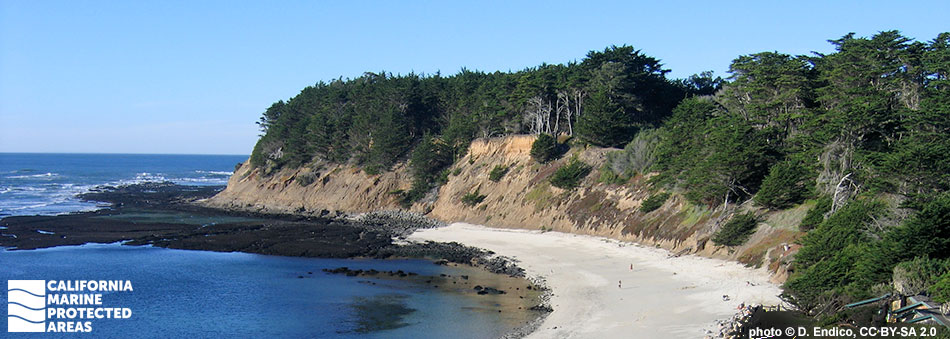
Overview
Montara State Marine Reserve (SMR) and Pillar Point State Marine Conservation Area (SMCA) are two neighboring marine protected areas (MPAs) located along the scenic coastline of San Mateo County, just south of San Francisco. Almost 12 square miles of marine habitat is protected within Montara SMR, to depths greater than 160 feet. And in Pillar Point SMCA, more than 6½ square miles of marine habitat is protected, to depths greater than 170 feet. These two MPAs feature sandy beaches, rocky shores, surfgrass beds, expansive sandy seafloor, and an immense rocky reef with kelp forests. The popularity of this coastal area is primarily due to the accessible and expansive rocky shoreline habitat. Spanning more than three miles, Montara SMR's rocky coast includes beautiful tidepools full of chitons, anemones, urchins, limpets, barnacles, crabs, and vibrantly colored nudibranchs (sea slugs).
The SMCA protects fish and invertebrates such as rockfish, lingcod, greenlings, surfperches, halibut, rays, and crabs. Offshore of Pillar Point, the reef structure is responsible for the exceptional surf break known as Mavericks, which is located near the southern boundary of Pillar Point SMCA.
With more than 300 species of invertebrates, fish, seabirds, and marine mammals, Montara SMR and Pillar Point SMCA offer visitors ample opportunity to appreciate California’s marine life both from shore and on the water.
Regulations
Montara SMR
It is unlawful to injure, damage, take, or possess any living, geological, or cultural marine resource.
California Code of Regulations Title 14, Section 632(b)(65)(opens in new tab)
Pillar Point SMCA
It is unlawful to injure, damage, take, or possess any living, geological, or cultural marine resource, EXCEPT:
Recreational take of Dungeness crab by trap, market squid by hand-held dip net, and pelagic finfish (northern anchovy, barracudas, billfishes, dorado (dolphinfish), Pacific herring, jack mackerel, Pacific mackerel, salmon, Pacific sardine, blue shark, salmon shark, shortfin mako shark, thresher shark, swordfish, tunas, Pacific bonito, and yellowtail) by trolling is allowed. Commercial take of Dungeness crab by trap, market squid by round-haul net, and pelagic finfish (no commercial take of marlin is allowed) by trolling or round-haul net is allowed. Not more than five percent by weight of any commercial pelagic finfish or market squid catch landed or possessed shall be other incidentally taken species.
California Code of Regulations Title 14, Section 632(b)(66)(opens in new tab)
Quick Facts
Montara SMR
MPA size: 11.81 square miles
Shoreline span: 3.2 miles
Depth range: 0 to 168 feet
Habitat composition*:
- Sand/mud: 8.26 square miles
- Rock: 8.65 square miles
Pillar Point SMCA
MPA size: 6.70 square miles
Shoreline span: 0.3 miles
Depth range: 0 to 174 feet
Habitat composition*:
- Sand/mud: 5.73 square miles
- Rock: 2.07 square miles
*Habitat calculations are based on three-dimensional area and may exceed the total MPA area listed above.